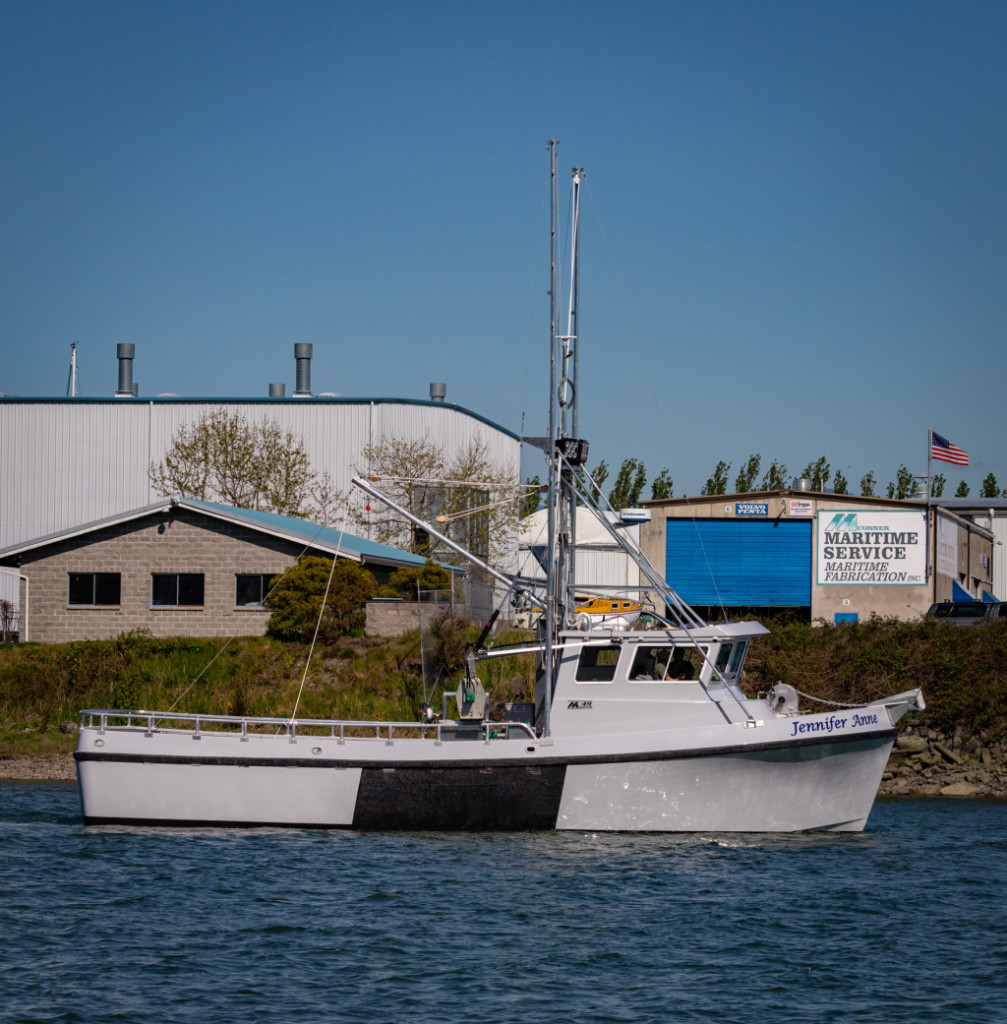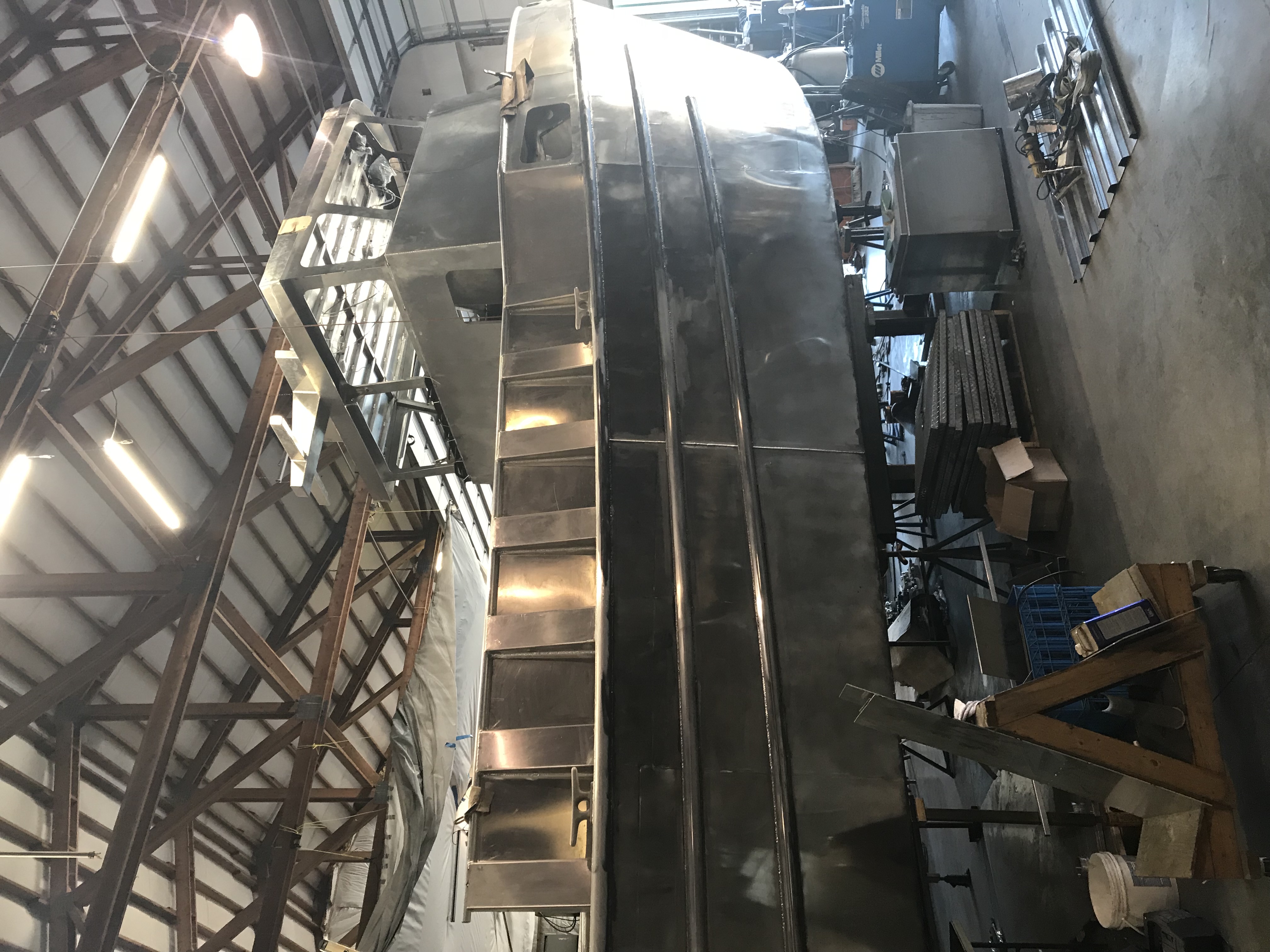Nearly two years ago, Strongback Metal Boats president Ole Oksvold said he was thinking about building a version of a jet-powered boat that could fish for salmon in Alaska’s Bristol Bay and spiny lobsters off the Southern California coast. Well, this September that idea could become reality with the completion of a 32' x 15' 6" aluminum combination boat at Strongback Metal Boats’ Seattle boatyard. “This boat is likely to go to California for spiny lobsters,” says Oksvold.
The 32-footer has an enclosed tophouse and is powered by a 730-hp MAN matched up with a 24-inch TraktorJet. For maneuvering, there’s a 10-inch Wesmar bow thruster.
The boat’s owner is an Alaska salmon fisherman who will have someone else run the boat in the winter, when it’s working Southern California’s spiny lobster grounds. Then it’s back to Seattle in the late spring to have the hauler used for pulling lobster traps removed from the starboard aft deck and the Kinematic net reel and power hauler installed for salmon gillnetting. (Both the net reel and hauler are removed for spiny lobster fishing to keep a clear, flush deck to stack lobster traps.) Then she will be barged to Alaska for Bristol Bay’s salmon season.
Accommodations for a crew of five include two sets of V-bunks plus a day bed in the tophouse for the captain. There’s also a head and shower. In the galley is a Wallas diesel stove for cooking and heating the cabin, which exits out the side of the house. That’s what Oksvold likes about the Wallas stove: “You don’t have a big exhaust that runs straight vertical up through the deck,” he says.
There will be a bit of a learning experience in sending the jet-powered 32-footer to California’s spiny lobster fishery, which often takes place in shallow water that can have a lot of kelp. The question is, can a jet-propelled boat maneuver through kelp as well as a prop-driven boat?
“We are going to find out,” says Oksvold. He says he talked with someone at NamJet, which produces the TraktorJet, and it appears “there are no TraktorJets in the spiny lobster fishery.”
One thing he is confident about is the ability of the jet-powered 32-footer to move a lot quicker when setting out spiny lobster traps than the boats currently in that fishery. “We’ll have a lot more speed,” he says, estimating the 32-footer will be good for 28 to 30 knots.
All in all, Oksvold thinks it makes a lot of sense to have the boat working both fisheries: “Otherwise, it would just sit around till the next spring.”
In May, Maritime Fabrication in La Conner, Wash., delivered a new 49' x 18' Dungeness crab boat to a fisherman in Crescent City, Calif. The Lynn Senour designed Jennifer Anne left Maritime Fabrication and headed down the West Coast powered by a 575-hp John Deere.
“The owner loves the boat,” says Maritime Fabrication’s Isaac Oczkewicz, noting that the Jennifer Anne has already been prawn fishing and will troll for salmon before crabbing in the fall, its main fishery.

A boat that was in the shop in August for repairs is Oczkewicz’s brother’s Bristol Bay gillnetter. This summer, about three weeks before Bristol Bay closed, another gillnetter ran into the side of the boat. “It was an inattention kind of thing,” explains Oczkewicz. Partial repairs were made, and the boat finished out the season. It will take some aluminum and fiberglass work to repair the damage.
Another Oczkewicz family-owned aluminum gillnetter on the shop floor is the Dano, a 32' x 16' Bristol Bay boat built last year for Ed Oczkewicz, Isaac’s father and founder of Maritimer Fabrication in 1978. It’s a bow and stern picker with a raised pilothouse on the stern. ”It’s nothing major,” says Oczkewicz, “ironing out a few new-boat bugs.”
Maritime Fabrication is scaling back on building new fiberglass boats to focus on retrofitting and repair work. However, the yard retains the molds. So if someone wants a fiberglass boat, Maritime Fabrication’s neighbor, Tomco Marine Group, a fiberglass shop, will do the fiberglass work, and Maritime Fabrication will do the outfitting.
Besides building boats, Maritime Fabrication has been designing and building deck machinery, such as anchor winches, gillnet rollers and reels, and level winds for commercial fishing boats for more than 35 years. Periodically improvements are made to the existing lineup. This year there were a couple of adjustments. One was an articulating base for a gillnet reel on a setnet application, and the other was adding heavy-duty bearings to the gillnet rotator base, which makes turning the drum easier, says Oczkewicz.







